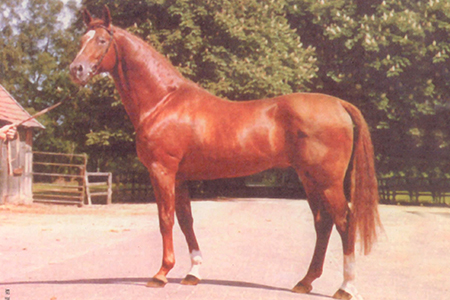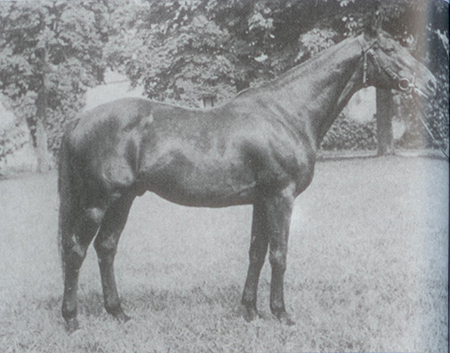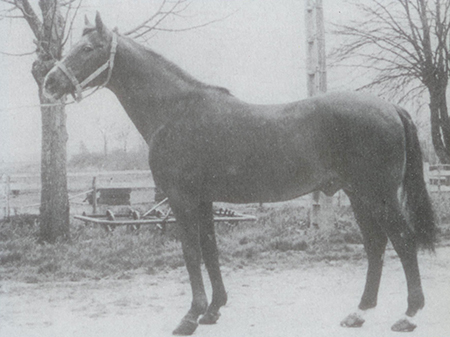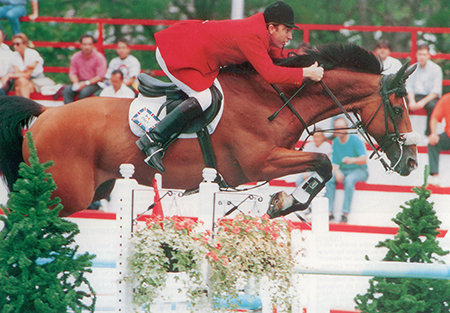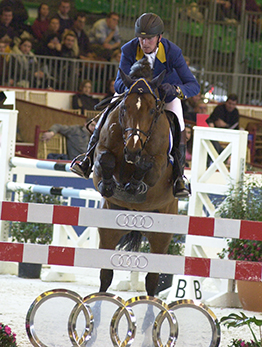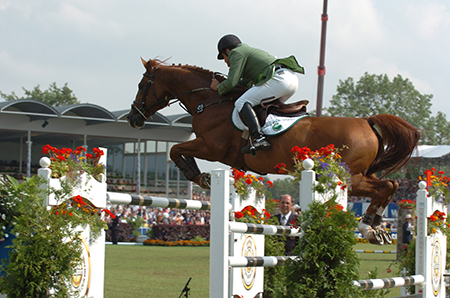1972 – 2001 169 cm Chestnut
Breeder: P Dambier
The chestnut stallion had three names and three homes: He started life as Gordios, then became Zeus and then Nurzeus and then back to Zeus again!
Zeus was a mix of Selle Français and Anglo Arab blood – in fact a pedigree analysis reveals that he was 85.94% ‘blood’.
His sire Arlequin was considered one of the heads of the Anglo Arab breed in France, but his influence never spread beyond that country. None of his progeny registered on the WBFSH stats, and his sons were to be found in the stables of the Haras Nationeaux – really Arlequin’s fame is because of Zeus.
Arlequin AA
Arlequin was born in 1963 and never raced or competed. He was a good sire of young horses. In 1986, he was the 12th best sire of 4/5 year olds in France.
Massondo AA
Arlequin’s sire, Massondo was more successful. He was the sire of Ryon d’Anzex, who carried the Spanish rider, Fernando Fourcade Lopez at the 1993 Euros and the 1994 WEG, and who became a respectable sire of jumpers. He also sired, Minipech who won the Grand Prix of Cannes and San Sebastien with Xavier Caumont – as well as Voltigeur a winner at an international level under both the Belgian and German flags.
Arlequin’s progeny were less successful, although Zeus’ sister Diablesse had a few minor international placings, and then produced a good eventer in Akwaba (by Pot d’Or) who was 42nd at the 1999 European Championships competing for Japan.
Goridos’ breeder, Pierre Dambier, was so impressed with the build and paces of the noble chestnut, that he decided to sell him at the prestigious Poitier Auction, where he was acquired by that dealer with an uncanny eye, who bought him for the then, quite considerable sum of FF40,000.
The equally uncanny German breeder, Georg Vorwerk, had already made the acquaintance of Lefevre, and it was from him that he purchased the great Furioso II, so when Lefevre announced that he was coming to the 1975 Equitana in Germany and bringing a super chestnut (neither Lefevre nor Vorwerk shared the anti-chestnut prejudice) stallion with him, Herr Vorwerk and the members of the Oldenburg Licensing committee were waiting for the pair to arrive. The Germans were suitably impressed and Vorwerk purchased the horse, renaming him Zeus as he was convinced he would start his own stallion line.
He was immediately licensed and commenced covering mares even before his successful 100 day test at Adelheidsdorf.
Following in the footsteps of Furioso, there was no need for Zeus to be shown since the mares flocked to him – up to 200 in the good years.
But as Pascal Renauldon points out in his excellent article, Zeus, God of the Oldenburg (Annuaire Monneron 2004) the results were not so successful: “Zeus products turned out to be quite highly strung, and especially with quite a complicated mouth. All on his own, Zeus was to establish in Germany, the reputation for the French horse’s difficult mouth. Good horses, blood, but maulig (bad mouth) could be heard at the show grounds. The breeders lost interest and the Vorwerks accepted with good grace the leasing proposal made to them by the Dutch Stud, Busker from 1982 to 1986.”
And once again, the chestnut acquired a new name in keeping with the year – so Nur Zeus or Nurzeus – it was.
Perhaps the Zeus progeny were more suited to the softer hands of the American riders, for that was where they first showed their talents. Rodney Jenkins won class after class with Playback (out of a mare by More Magic xx) – they won the American League of the World Cup in 1986.
Ian Millar found there was life after Big Ben, with Czar (Westfalien bred out of a mare by another Thoroughbred, Lucius), the pair were 12th at the 1990 World Cup finals in Dortmund, and with Lonesome Dove (out of a Furioso II mare) he won the Grand Prix of Dortmund in 1990.
With these good international results, Zeus was approved by ten German studbooks, and also in Belgium, Holland, Austria, Switzerland and France – although his popularity in his homeland was at best, moderate. Most of these studbooks also acquired sons of Zeus, although the story of his most successful early son, Burisso, is wonderful indeed. Again, let Pascal tell the tale:
“Burisso (foaled in 1983, mother by Nominaal) was born in Jan Nijhoff’s stable, who sold him as a yearling to the Dutch dealer Jan Maathuis, who himself sold him to Mr Roelink. Mr Roelink broke him in and castrated him. But, beforehand, without having been approved, Burisso covered two mares, and today there are two horses somewhere in Europe who can boast their Burisso paternity! Burisso had an enormous amount of temperament, and a generosity in front of the jump that was almost violent. An informer of Michael Whitaker’s spotted the horse in Holland and called the British champion one evening. Hooked by his informer’s enthusiasm, Michael tried at once to reach the owner, Phil Harris, by phone. But the man could not be found. Michael would not give up and finally managed to reach him in the middle of the night. Harris agreed to Michael’s proposal, and Michael phoned back his friend in Holland to confirm the deal. The final transaction was made during this ‘mad’ night, and that was why the horse was renamed… Midnight Madness!”
Midnight Madness and Michael Whitaker
The rest is history. In 1993 Midnight Madness was crowned jumper of the year by the WBFSH, having won the Grand Prix – and Nations Cup – at Hickstead, the Mercedes Prize at Aachen, the Grand Prix of Olympia and Zuidlaaren as well as taking home Team Silver and Bronze individual from the European Championships at Gijon.
The Zeus show was on the road. Stars included: Zypria (Atlas) with Dirk Hauser and Elise Haas, Ennio (Apple King xx) and Fernando Sarasola. Zodiac (Polydor) and Holger Hetzel, Virtual Village Zalza (Winnetou) and Nick Skelton, Latina (Buenaventura xx) and Bruno Rocuet, Zandor Z (Polydor) and Jos Lansink…
Zandor Z and Jos Lansink
Zeus was also an excellent sire of broodmares, the most stunning example being Tinka’s Boy, by Zuidpool, not notably a sire of Grand Prix horses, but out of Esprit by Zeus.
Tinka’s Boy at Aachen
On the WBFSH rankings from 1990 to 2000, Zeus was ranked 6th with 34 representatives.
Zeus produced 21 licensed stallions, 892 out of 2000 registered sport horse descendants won DM4.5 million while 46 mares were crowned with the State Premium Title.
When Zeus died in 2001, he was the last French stallion at the Vorwerk Stud, with George Vorwerk’s daughter, Gudela commenting: “The French has given the wrong direction to their breeding. They base themselves of the BLUP ratings. The stallions are no longer noble enough, and they don’t have any more paces left. You can’t find Anglo-Arabs with Inschallah’s charisma any more in France. The horses are not modern enough anymore, they are getting heavier. German stallion keepers don’t look towards France any longer.”
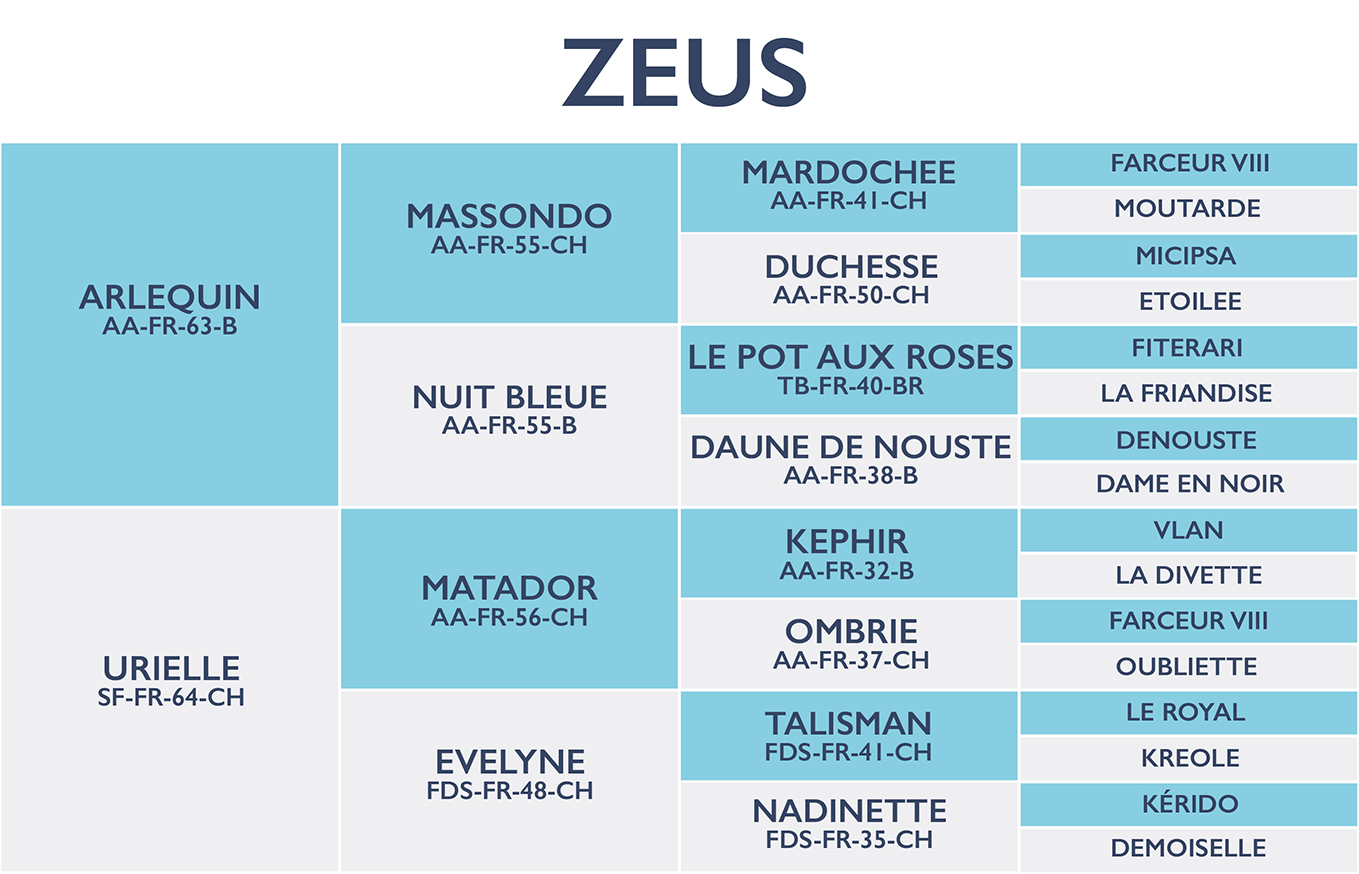
« Back to Great Stallions List

